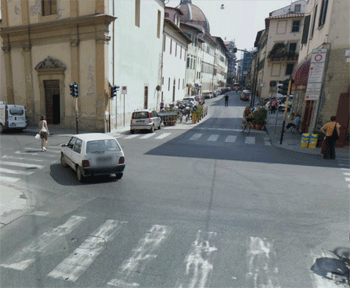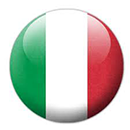This crossroads, where Via della Madonna, Via Puccini, and Corso Gramsci meet, is known by the people of Pistoia as 'Saint Vitale's crossroads', as the name comes from the church in one of the corners. The area today is clearly modern, but the remainders of old Pistoia, can still be found. The long straight road which constitutes Via Puccini, Via della Madonna and Via degli Orafi leads directly to Piazza del Duomo which is the ancient heart of the town. This road corresponds exactly to the route of the ancient consular road Cassia which was made by the Romans in the 2nd century before Christ, during the period in which they were fighting against the Liguri. Pistoia was founded on this road which connected Florence, Lucca and Luni, and its original name was Pistoria, a name which probably originated from the latin pistores, which means bakers, with a clear reference to the role of the town in baking bread for the soldiers.
Pistoia was originally a military camp, with a geometric layout based on two principal axis, the cardo and the decumano (the decumano coincides with Via Cassia). It then became an oppidum, a town surrounded by walls, which was completely destroyed during the invasion of the Gots of Radagaiso and was then rebuilt.
The assets of the town as it is nowadays have a singularly medieval origin. This is shown by the three lines of city walls of which signs can still be seen. Looking at the roads and at what is left of the ancient stones, it is still possible to distinguish the remains of the ancient city walls which defended the town over the centuries, a town that was first a 'cittadella longobarda' (lombard city) and then a 'libero commune' (free city-state).

The first line of walls built in the 8th century, only protected a small area around Piazza Duomo, then, in the 12th century, the area of the city was quadrupled by a new line of walls. The route of this second line of walls is documented to have been right at the Saint Vitale crossroads, along what is now Corso Gramsci. The line was completely destroyed after the attack on Pistoia by Florence and Lucca in 1306. The last line of city walls was built in the 14th century, and included the big convents, the hamlets along the principal roads and above all a series of orchards, that were left unaltered right up until the beginning of the 20th century. This fortification was strengthened in 1500, when Pistoia was already part of the 'Granducato di Toscana' (Grand Duchy of Tuscany), with the building of the fortified bastions and of the 'Fortezza di Santa Barbara' (Saint Barbara's Fortress). Close to the 'incrocio di San Vitale' (Saint Vitale's crossroads) and every 25th of July, the people of Pistoia have been able to assist in the 'Palio de Barberi' (Palio of the Barbary horses). This is a spectacular horse race, which was started in honour of Saint Jacopo, the patron saint of the city. The tradition continues until this day even if the celebration has changed slightly over the centuries.

The first line of walls built in the 8th century, only protected a small area around Piazza Duomo, then, in the 12th century, the area of the city was quadrupled by a new line of walls. The route of this second line of walls is documented to have been right at the Saint Vitale crossroads, along what is now Corso Gramsci. The line was completely destroyed after the attack on Pistoia by Florence and Lucca in 1306. The last line of city walls was built in the 14th century, and included the big convents, the hamlets along the principal roads and above all a series of orchards, that were left unaltered right up until the beginning of the 20th century. This fortification was strengthened in 1500, when Pistoia was already part of the 'Granducato di Toscana' (Grand Duchy of Tuscany), with the building of the fortified bastions and of the 'Fortezza di Santa Barbara' (Saint Barbara's Fortress). Close to the 'incrocio di San Vitale' (Saint Vitale's crossroads) and every 25th of July, the people of Pistoia have been able to assist in the 'Palio de Barberi' (Palio of the Barbary horses). This is a spectacular horse race, which was started in honour of Saint Jacopo, the patron saint of the city. The tradition continues until this day even if the celebration has changed slightly over the centuries.


